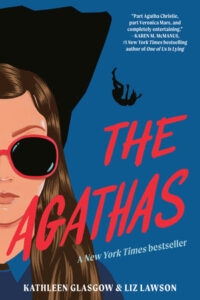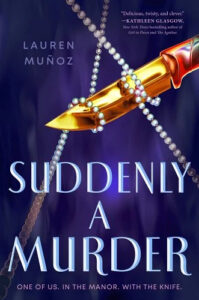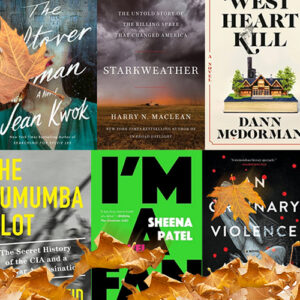When I was a child, my dad used to set me puzzles at the dinner table. Sometimes they were riddles (“How did the man get out of the locked room with only a baseball bat? He swung three times and struck out.”), but often they were logic puzzles (My favorite was the river crossing puzzle; try it here). It was also the heyday of game developers like The Learning Company and Sierra Entertainment, and since my dad was an early adopter of computers, I spent long hours poring over clues in Midnight Rescue!, Where in the World Is Carmen Sandiego?, and King’s Quest V, never growing bored so long as there was a puzzle to be solved. It’s no surprise, then, that I grew up to love Golden Age detective fiction, whose authors delighted in creating tricky puzzles for their readers.
Golden Age detective fiction generally refers to mysteries published during the 1920s and 1930s, between World War I and World War II. This is the era that gave us detectives like Hercule Poirot and plots like the country house murder, where a much-despised victim dies and a clever detective has to figure out which member of the house party did them in. It’s a setup I love so much that I used it for my young adult debut, Suddenly a Murder, where seven teenagers throw a 1920s graduation party at a glamorous manor until one of them turns up dead. The detective that shows up to investigate the murder is Pilar de León, a Mexican PI who dresses like a steampunk witch and is every bit as bold and clever as Poirot.
Puzzle mysteries exploded in popularity during the 1920s, which many critics attributed to readers’ desire to escape into low-stakes worlds after the twin horrors of World War I and the 1918 flu pandemic. I wonder, also, if they enjoyed fair play mysteries because they could actively engage with the plots in a way they couldn’t with other fiction. Instead of a linear conversation between an author and her passive audience, a reader could participate in a zigzagging chase, collecting and analyzing clues while the author tried to stay one step ahead by planting red herrings and seeding misdirection. After years of being forced to endure a violent reality they couldn’t control, might there have been something uniquely compelling about the chance to play detective?
If so, I’m glad an increasing number of young adult authors are bringing our love of puzzles and amateur detectives to high school, an age group that’s perfect for the early Golden Age style, which avoids graphic violence and dark psychology in favor of a lighter tone. Even when they’re not experiencing crises like wars and pandemics, there’s a large gap between how much agency teenagers want and how much they actually have. Their personal space is circumscribed by days spent under the thumbs of parents and teachers, endless hours scrolling apps designed to steal their time and attention, and the oppressive knowledge that the world they’re inheriting is less livable than at any time in recent memory. Young adult mysteries can provide them with the opportunity to take control of a narrative when they can’t easily control their own.
Not that young adult novels are just for teenagers. While some adult readers might find the idea of fictional teen detectives too contrived, artificiality—a hallmark of Golden Age fiction—is what creates the emotional space for readers to be playful. Darker, more psychologically incisive books written by authors like Raymond Chandler, who scorned the artificiality of traditional English mysteries, generally make their detectives and their troubles all too realistic; Philip Marlowe’s lack of agency as a down-on-his-luck PI might provoke our sympathy, but it doesn’t make us want to step into his shoes. It’s the difference between defusing a bomb in real life versus a video game; both are engaging, but one makes you cry, while the other makes you smile.
Of course Chandler had little use for making people smile, and I think it’s because he was more interested in the experience of storytelling than in having an ongoing dialogue with his readers. In his essay, “The Simple Art of Murder,” we learn that Chandler disliked the “exhausting” process of clue-weaving, disdained elaborate puzzle constructions, and derided the kind of murderous motives that existed only to “provide a corpse” for the plot. He knew that every story was contrived, but he wanted things to feel real when he wrote them, and that’s impossible when you’re trying to devise a way for the butler to have bumped off a grumpy patriarch with nothing but a puppet and an air vent in the pantry.
I’m not knocking Chandler. I like Philip Marlowe so much I named the love interest in my debut after him. But put simply: Chandler didn’t want to be a programmer. The people who made King’s Quest V weren’t concerned with whether the players felt pangs of real thirst as they crossed the Endless Desert, but they did care about how well the levels played, and they placed clues in locations that would challenge but not defeat those who took them on. In this way, they delicately balanced guiding players through the game with making sure those players had the agency to make mistakes in game play and logic. Puzzle mysteries work the same way: Authors construct unreal worlds full of eccentric characters and convoluted murders for their readers to explore, with every sentence functioning both to push the plot forward and to be collected for future use, like a coin or talisman. And while there is always an awareness that you’re engaging with something contrived, the best versions of these mysteries are as immersive as any game, allowing the player-reader to move through the chapters like they’re levels, accumulating new information and getting closer to the possibility of solving the murder.
When I look back on my childhood, I think what my dad taught me at the dinner table was to appreciate the dynamic of interactive challenges and to approach clues playfully (“How did the man get out of the locked room with only a banana peel? He slipped on it and wiped out.”). As schools and social media become places of higher stakes for young adults, I’m happy to be writing mysteries where they can reclaim some agency without worrying about failing. The worst that can happen is they play detective and pick the wrong killer. And since readers dearly love to be tricked, they can move on to the next mystery with a smile, determined this time to outplay the master programmer.
If you’d like to set your wits against some twisty young adult mysteries, check out:

Truly, Devious by Maureen Johnson
A teen true-crime aficionado gets accepted into a private school in Vermont where she plans to solve the famous disappearance of its founder’s daughter. It features many of the Golden Age’s best tropes and pulls its cold case from a real crime that also inspired Murder on the Orient Express.

The Agathas by Kathleen Glasgow & Liz Lawson
After disappearing for a week a la Agatha Christie, Alice Ogilvie returns to find herself embroiled in the murder investigation of her ex-bff. It’s a good thing she has the words of her favorite novelist to help her solve the crime.
And finally, a game recommendation:

Return of the Obra Dinn by Lucas Pope/3909
Everyone on board this ghost ship is dead, and you play an investigator trying to discover how each person met their end. As soon as I finished, I wanted to go back and play it again.
***


















